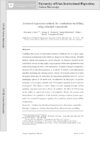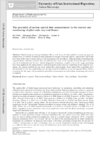|
|
Creator | Title | Description | Subject | Date |
| 1 |
 |
Pershing, David W.; Wendt, Jost O. L. | Pulverized coal combustion: NOx formation mechanisms under fuel rich and staged combustion conditions | A 2 Kg/h pulverized fuel one dimensional flame combustor was used to determine time resolved NO profiles under fuel rich and staged combustion conditions. Seven solid fuels, including two coal chars, were investigated. Results show that at all fuel rich conditions NO is formed rapidly and then is ... | Flame; Composition; Reaction | 1979 |
| 2 |
 |
Sutherland, James Clayton; Kerstein, Alan R.; Chen, Jaqueline H. | An evaluation of the one-dimensional turbulence model: comparison with direct numerical simulation of CO/H2 jets with extinction and reignition | Abstract A variant of the One-Dimensional Turbulence (ODT) model formulated in an Eulerian reference frame is applied to a planar nonpre mixed turbulent jet flame and results from the model prediction are compared with DNS data. The model employed herein solves the full set of conservation equation... | | 2010 |
| 3 |
 |
Sarofim, Adel F.; Pugmire, Ronald J. | 13C NMR analysis of soot produced from model compounds and a coal | Soot samples, including the associated organics, produced from an Illinois No. 6 coal (five samples) and two model compounds, biphenyl (three samples) and pyrene (two samples), have been studied by 13C NMR methods. The coal soot data served as a guide to selection of the temperature range that would... | 13C NMR; Biphenyl; Aromatic cluster size | 2001 |
| 4 |
 |
Whitty, Kevin J. | A system for measuring bubble voidage and frequency around tubes immersed in a fluidized bed of particles | Gas-solid fluidized beds are common in chemical processing and energy production industries. These types of reactors frequently have banks of tubes immersed within the bed to provide heating or cooling, and it is important that the fluid dynamics within these bundles is efficient and uniform. This p... | | 2010 |
| 5 |
 |
Sutherland, James Clayton | A filter-independent model identification technique for turbulent combustion modeling | In this paper, we address a method to reduce the number of species equations that must be solved via application of Principal Component Analysis (PCA). This technique provides a robust methodology to reduce the number of species equations by identifying correlations in state-space and defining new v... | | 2012-01-01 |
| 6 |
 |
Pershing, David W. | Design and construction of a rotary kiln simulator for use in studying the incineration of hazardous waste | Rotary kilns have been used extensively in the cement industry to calcine limestone. In the past few years, the technology has been viewed as a possible option for the incineration of hazardous waste materials, especially for the disposal of solid wastes and the cleanup of contaminated soils and tra... | Rotary kilns; Hazardous waste; Waste burning | 1989-08 |
| 7 |
 |
Pershing, David W. | Influence of fuel composition and flame temperature on the formation of thermal and fuel NOx in residual oil flames | A 900 kw model package boiler and a 20 kw laboratory tunnel furnace were used to study fuel and thermal NO, formation during heavy oil combustion. Package boiler results indicated that atomizer design, spray/ flow field interactions, and fuel composition were significant, dependent parameters. These... | Residual oil flames | 1979 |
| 8 |
 |
Eddings, Eric G.; Sarofim, Adel F. | Fast cook-off tests report | The Center for the Simulation of Accidental Fires and Explosions (C-SAFE) at the University of Utah is focused on providing science-based tools for the numerical simulation of accident scenarios involving fires and high-energy devices (Pershing, 2000). The initial computational efforts are concentra... | Heat flux; Heat transfer; Cookoff tests; Center for the Simulation of Accidental Fires and Explosions; C-SAFE | 2003 |
| 9 |
 |
Lighty, Joann; Silcox, Geoffrey | Fundamentals of mercury oxidation in flue gas | This report was prepared as an account of work sponsored by an agency of the United States Government. Neither the United States Government nor any agency thereof, nor any of their employees, makes any warranty, express or implied, or assumes any legal liability or responsibility for the accuracy, ... | | 2006 |
| 10 |
 |
Pershing, David W.; Wendt, Jost O. L. | Pulverized coal combustion: the influence of flame temperature and coal composition on thermal and fuel NOx | A laboratory combustor was used to investigate the factors that influence the conversion of fuel nitrogen in coal during coal combustion. Fuel NO was isolated by experimentation utilizing Argon / Oxygen / Carbon Dioxide mixtures as the oxidant, and care was taken to compare cases with air at matche... | Fuel nitrogen; Flame temperature; Coal composition | 1977 |
| 11 |
 |
Pershing, David W. | Biomass combustion: relationship between pollutant formation and fuel composition | A 65-kW refractory-walled reactor was used to study biomass combustion under conditions typical of the suspension-burning phase in a spreader-stoker-fired boiler. Isothermal combustion data and nitric oxide (NO) emission rates were obtained as a function of temperature, local oxygen concentration, ... | Combustion; Emissions; Energy; Environmental control; Fuels; Pyrolysis; Biomass fuel; Particulates | 1989 |
| 12 |
 |
Sarofim, Adel F. | Simulation of soot formation using particle dynamics with one dimensional nucleation mode | Two soot formation models using particle dynamics with one-dimensional nucleation mode directly coupled with gas phase chemistry are tested on three ethylene and three methane laminar premixed flames. These models demonstrate strength in the prediction of concentration profiles of major combustion p... | Soot formation models; Particle dynamics; One dimensional nucleation mode; Combustion chemistry | 2004 |
| 13 |
 |
Eddings, Eric G.; Sarofim, Adel F. | Experimental study of burning rate in jet-fuel pool fires | Experiments were carried out in a 30 cm diameter pool fire, for both transient and steady-state conditions, utilizing jet fuel, Norpar-15, and a surrogate mixture of hydrocarbons that simulates jet-fuel behavior in a pool fire. Steady state pool fire tests match previous results well. The transient ... | Pool fires; Jet propulsion fuel; Norpar-15 | 2004 |
| 14 |
 |
Sutherland, James Clayton | Advanced regression methods for combustion modelling using principal components | Modelling the physics of combustion remains a challenge due to a large range of temporal and physical scales which are important in these systems. Detailed chemical kinetic mechanisms are used to describe the chemistry involved in the combustion process yielding highly coupled partial differential e... | | 2014-01-01 |
| 15 |
 |
Smith, Philip J. | Reduced-order PCA models for chemical reacting flows | One of the most challenging aspects of turbulent combustion research is the development of reduced-order combustion models which can accurately reproduce the physics of the real system. The identification and utilization of the low dimensional manifolds in these system is paramount to understand and... | | 2014-01-01 |
| 16 |
 |
Eddings, Eric G.; Sarofim, Adel F.; Pugmire, Ronald J. | Selection of surrogates for jet fuels | Abstract: A. detailed characterisation of JP fuels is provided based on literature data for the average of 55 worldwide and 4 US Jet-A fuels. These are complemented by NMR analysis of a JP-8 that provides the fractions of the carbon in the fuel that are present as protonated, bridgehead, and non-sub... | Jet propulsion fuel; Surrogates; Simulations | 2008 |
| 17 |
 |
Eddings, Eric G.; Sarofim, Adel F. | Modeling benzene and naphthalene formation in a premixed propylene flame | The Utah Surrogate Mechanism was used to model a fuel-rich, non-sooting premixed laminar flame of propylene at 5000 Pa with an equivalence ratio of 2.32. The simulation results were found to be satisfactory in comparison with the experimental data. For example, the measured concentration profiles of... | Utah Surrogate Mechanism; Propylene; Combustion modeling; Benzene formation; Naphthalene formation | 2005 |
| 18 |
 |
Eddings, Eric G. | The potential of on-line optical flow measurement in the control and monitoring of pilot-scale oxy-coal flames | Digital image processing techniques oer a wide array of tools capable of extracting apparent displacement or velocity information from sequences of images of moving objects. Optical flow algorithms have been widely used in areas such as traffic monitoring and surveillance. The knowledge of instantan... | | 2014-01-01 |
| 19 |
 |
Pershing, David W.; Wendt, Jost O. L. | Investigation of first- and second-stage variables on control of NOx emissions using staged combustion in a pulverized coal wall-fired furnace | Recent tests on an EPA 1- to 1.5 x 106 Btu/hr pilot-scale pulverized coal furnace show that N0X emissions of 100 ppm to 150 ppm (zero percent 02) are achievable with the use of two-stage combustion. Comparable N0X emission levels were obtained with three different coal types fired in either the sing... | NOx; Carbon monoxide; Emissions | 1979 |
| 20 |
 |
Pershing, David W. | Bench and pilot scale process evaluation of reburning for in-furnace NOx reduction | This paper describes a combined experimental and theoretical study which was undertaken to quantify the impact of fuel and process parameters on reburning effectiveness and provide the scaling information required for commercial application of reburning under highly varied industrial conditions. Ini... | Reburning; Nitrogen oxides reduction; Staged fuel injection | 1986 |
| 21 |
 |
Eddings, Eric | Modified CPD Model for Coal Devolatilization at UCTT Conditions | To study coal pyrolysis behavior at underground coal thermal treatment (UCTT) conditions, a modified CPD (M-CPD) model was developed and evaluated using two scales of experiments as well as two different coals, Utah Sufco and Illinois #6. Compared with the original CPD model, three major aspects wer... | Coal; pyrolysis; modeling; underground heating | 2019 |
| 22 |
 |
Eddings, Eric G.; Spinti, Jennifer C.; Smith, Philip J. | Soot volume fraction from extinction in JP-8 and heptane pool fires | Total extinction measurements from a multiple beam experiment using a 10mW laser diode are presented and compared to calculate soot volume fraction in heavily sooting pool fires from a 150 mm diameter pan of Jet Propulsion fuel 8 (JP-8) and heptane. Trends in attenuation are critiqued for the t... | Pool fires; Jet propulsion fuel | 2005 |
| 23 |
 |
Pershing, David W.; Slaughter, David Michael | Parameters influencing the evolution and oxidation of sulfur in suspension phase coal combustion | Stoker coal-fired boiler furnaces are significant in terms of coal consumption and environmental impact; however, they have received relatively little research attention. This paper describes the results of a two-year study on the formation of sulfur oxides in the suspension phase of a coal-fired s... | Stoker coal-fired furnaces | 1983 |
| 24 |
 |
Eddings, Eric G.; Smith, Philip J. | Soot volume fraction from extinction in JP-8 and heptane pool fires | Total extinction measurements from a multiple beam experiment using a 10mW laser diode are presented and compared to calculate soot volume fraction in heavily sooting pool fires from a 150 mm diameter pan of Jet Propulsion fuel 8 (JP-8) and heptane. Trends in attenuation are critiqued for the t... | Soot volume fraction; Heptane pool fires; JP-8 pool fires; Heavily sooting pool fires; Laser diagnostics | 2005 |
| 25 |
 |
Pershing, David W. | Mechanisms of NOx formation and control: alternative and petroleum-derived liquid fuels | Petroleum-, coal- and shale-derived liquid fuels were burned in a downfired tunnel furnace to assess the impact of fuel properties on the formation and control of NOx emissions. A nitrogen-free oxidant mixture (Ar, C02 , 02) was used to isolate fuel NOx formation. Under excess air conditions fuel N... | Exhaust emissions; Alternative fuels; Petroleum-derived liquid fuels | 1981 |

























